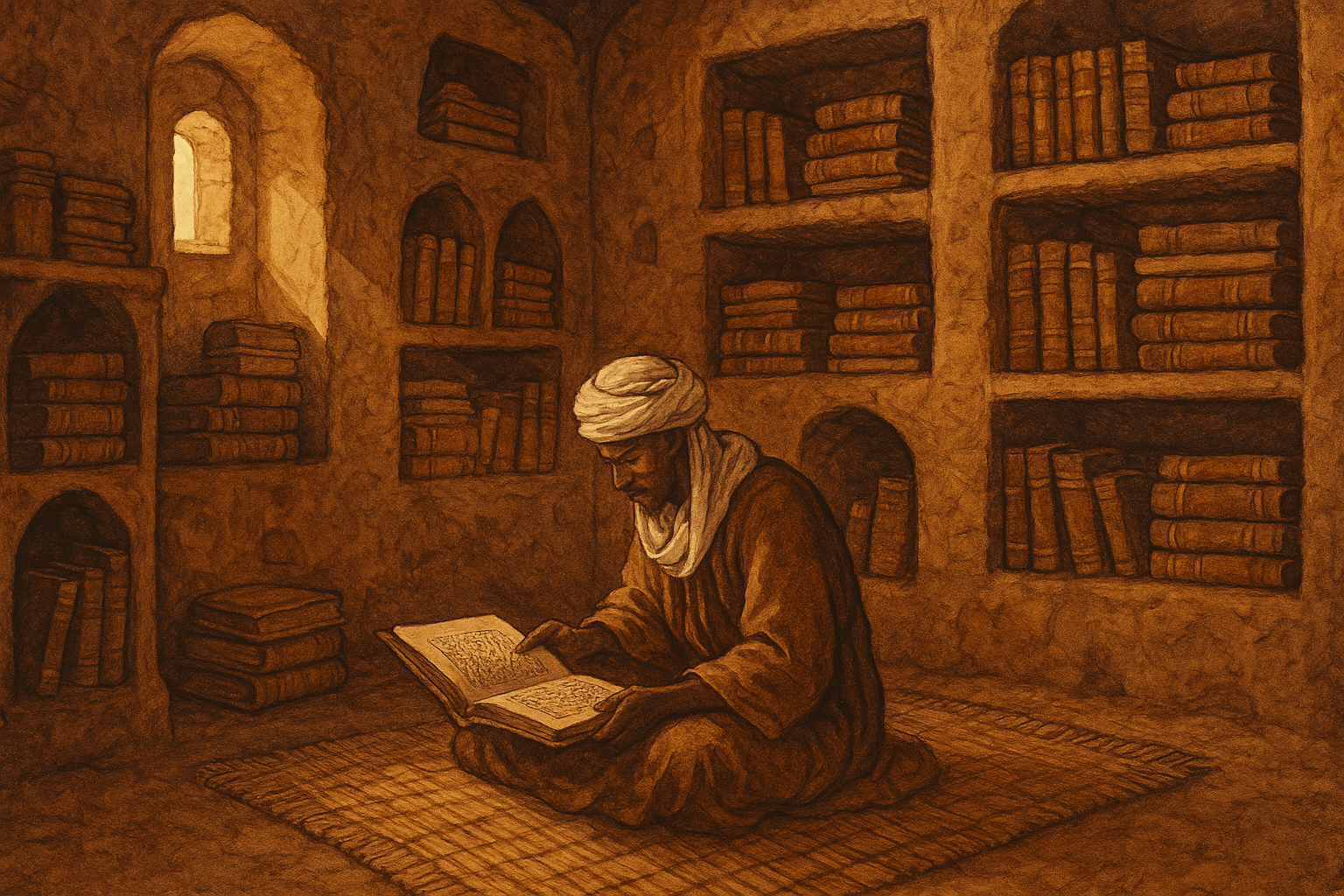From Desert Outpost to Golden City
To understand the libraries, you must first understand the city. Timbuktu, located in modern-day Mali, was not built in a lush river valley. It stood on the edge of the world’s greatest desert, a strategic position where the Niger River bends north into the sands. This location made it the perfect nexus for the vast trans-Saharan trade routes. From the north came caravans bearing salt, cloth, and horses. From the south came the immense wealth of West Africa: ivory, slaves, and, most famously, gold.
During the height of the Mali Empire (c. 1230-1600) and later the Songhai Empire (c. 1464–1591), Timbuktu became one of the world’s most prosperous cities. Its fame in Europe and the Middle East was cemented by the legendary 1324 pilgrimage of the Malian emperor, Mansa Musa. His procession, laden with so much gold that it reportedly devalued the currency in Cairo for over a decade, put Timbuktu on the map as a city of unimaginable wealth. But Mansa Musa brought back more than just a reputation; he returned with architects, scholars, and a renewed vision for Timbuktu as a center of Islamic learning.
Not One Library, But Hundreds
Here is where Timbuktu diverged from Alexandria. There was never one single, state-sponsored “Great Library of Timbuktu.” Instead, the city fostered something arguably more profound: a decentralized, deeply ingrained culture of literacy and scholarship. Knowledge was not housed in a single monumental building but was curated in dozens of private libraries, lovingly maintained in the homes of the city’s elite scholars, judges, and merchants.
Families like the Kati, Arait, and Aqit became custodians of vast collections, passed down through generations. These libraries were a symbol of status far more valuable than gold. To own a rare book, to commission a new copy, or to have a famous text in your collection was a mark of immense prestige. Scribes and copyists were a vital part of the city’s economy, meticulously reproducing texts by hand. It is said that in Timbuktu’s golden age, the book trade was the most profitable business of all.
A Universe of Knowledge on Paper and Parchment
The sheer volume of this literary tradition is staggering. Estimates suggest that at its peak, Timbuktu and the surrounding region held between 400,000 and 700,000 manuscripts. These were not just religious texts. While the Quran and Islamic jurisprudence formed the core of the collections, the subjects branched out to encompass the full spectrum of human inquiry, directly challenging the Eurocentric narrative of an African “dark age.”
The manuscripts of Timbuktu contained:
- Astronomy: Detailed star charts and astronomical tables, not just for determining prayer times but for navigation across the vast, featureless desert.
- Mathematics: Works on algebra, geometry, and complex arithmetic that demonstrate a sophisticated understanding of mathematical principles.
- Medicine: Treatises on surgery, pharmacology, and ethics in patient care, including texts on ophthalmology and the properties of local plants.
- Philosophy: Commentaries on the works of Greek philosophers like Aristotle and Plato, which had been preserved and studied in the Arab world and transmitted across the Sahara.
- History & Geography: Chronicles of the West African empires, dynastic histories, and detailed descriptions of trade routes and distant peoples. The Tarikh al-Sudan and Tarikh al-Fattash are two famous examples chronicling the history of the Songhai Empire.
- Law and Human Rights: Rulings on everything from business contracts and property rights to ethical governance and tolerance for other cultures.
Written primarily in Arabic script, these works were composed in several languages, including Arabic, Songhai, Tamasheq, and Fulfulde, showing a vibrant, multilingual intellectual environment.
Invasion, Neglect, and a Modern-Day Heist for Humanity
Timbuktu’s golden age came to a violent end in 1591 with a Moroccan invasion. The invaders, armed with muskets, shattered the Songhai Empire. They looted the city, killed some scholars, and exiled others, including the renowned Ahmed Baba, who was forced to leave his library of over 1,600 volumes behind. The city’s intellectual heart was broken.
In the centuries that followed, the precious manuscripts did not vanish entirely. Fearing theft and destruction, families went to extraordinary lengths to protect their heritage. They hid the books in mud-brick walls, buried them in chests in the desert, and secreted them away in remote villages. The culture of preservation went underground, a sacred trust passed from parent to child.
This ancient threat found a horrifying modern echo. In 2012, extremist groups linked to Al-Qaeda seized control of northern Mali, including Timbuktu. Declaring the manuscripts’ Sufi-inflected scholarship to be idolatrous, they began destroying tombs and threatened the libraries. The world watched in horror, fearing a cultural catastrophe. What followed was one of the most remarkable rescue operations in modern history. A quiet archivist named Abdel Kader Haidara, along with a network of librarians, families, and smugglers, orchestrated a plan. Over several months, they smuggled an estimated 350,000 manuscripts out of the city in metal and wooden trunks, using cars, boats, and donkey carts, right under the noses of the occupiers. It was a heist for the sake of humanity’s shared heritage.
The Enduring Legacy of Timbuktu
Today, these rescued manuscripts are primarily housed in the capital of Bamako, where they are being painstakingly preserved, digitized, and studied. They are more than just old books; they are irrefutable proof of a sophisticated, literate, and scientifically advanced society in West Africa that flourished while Europe was just emerging from its own medieval period.
The story of Timbuktu compels us to broaden our definition of a “great library” and to challenge our assumptions about where knowledge resided in history. It wasn’t just in the stone halls of Alexandria but also in the quiet courtyards of a golden city in the Sahara, a beacon of learning that time, invasion, and extremism could not extinguish.
